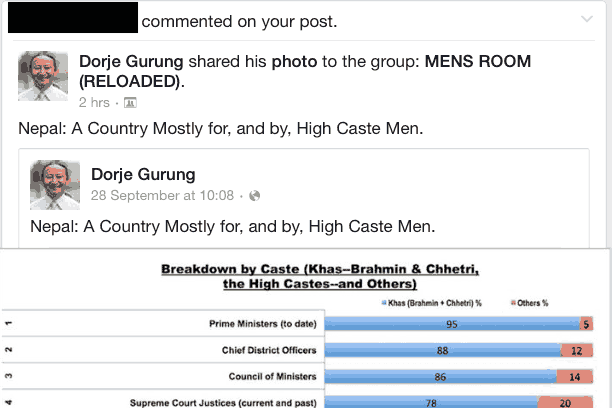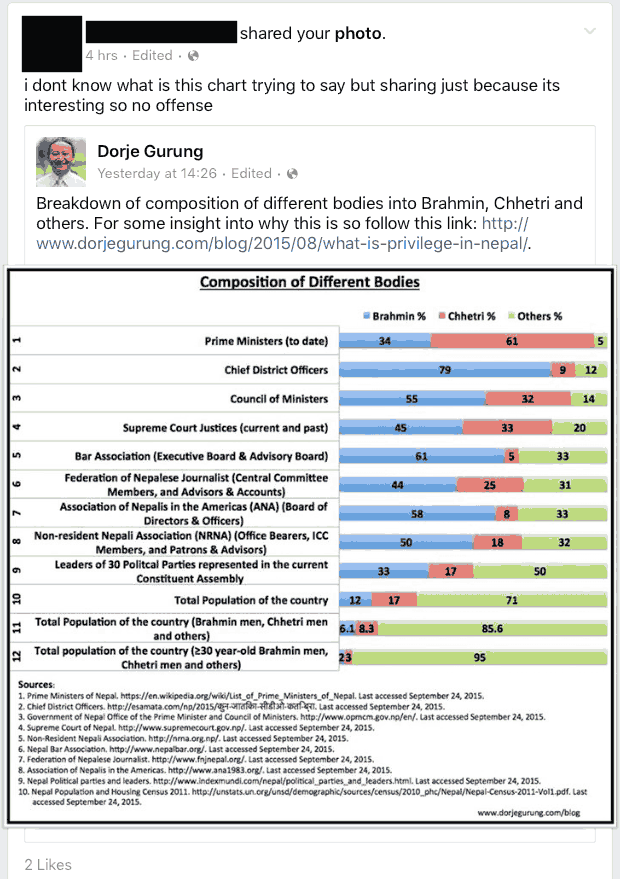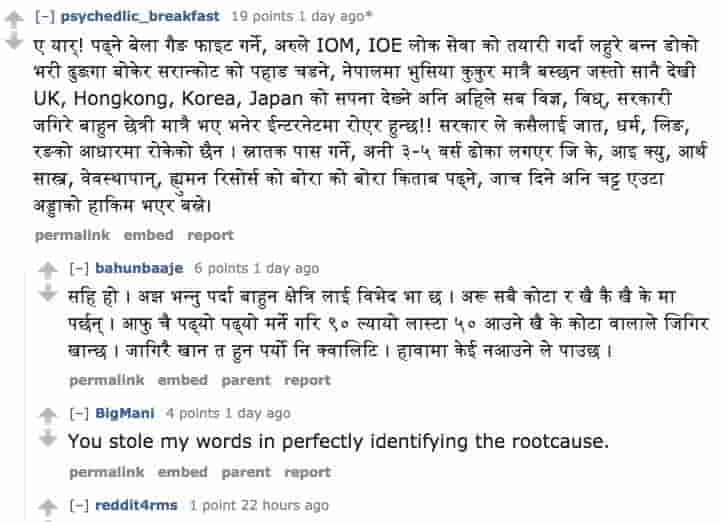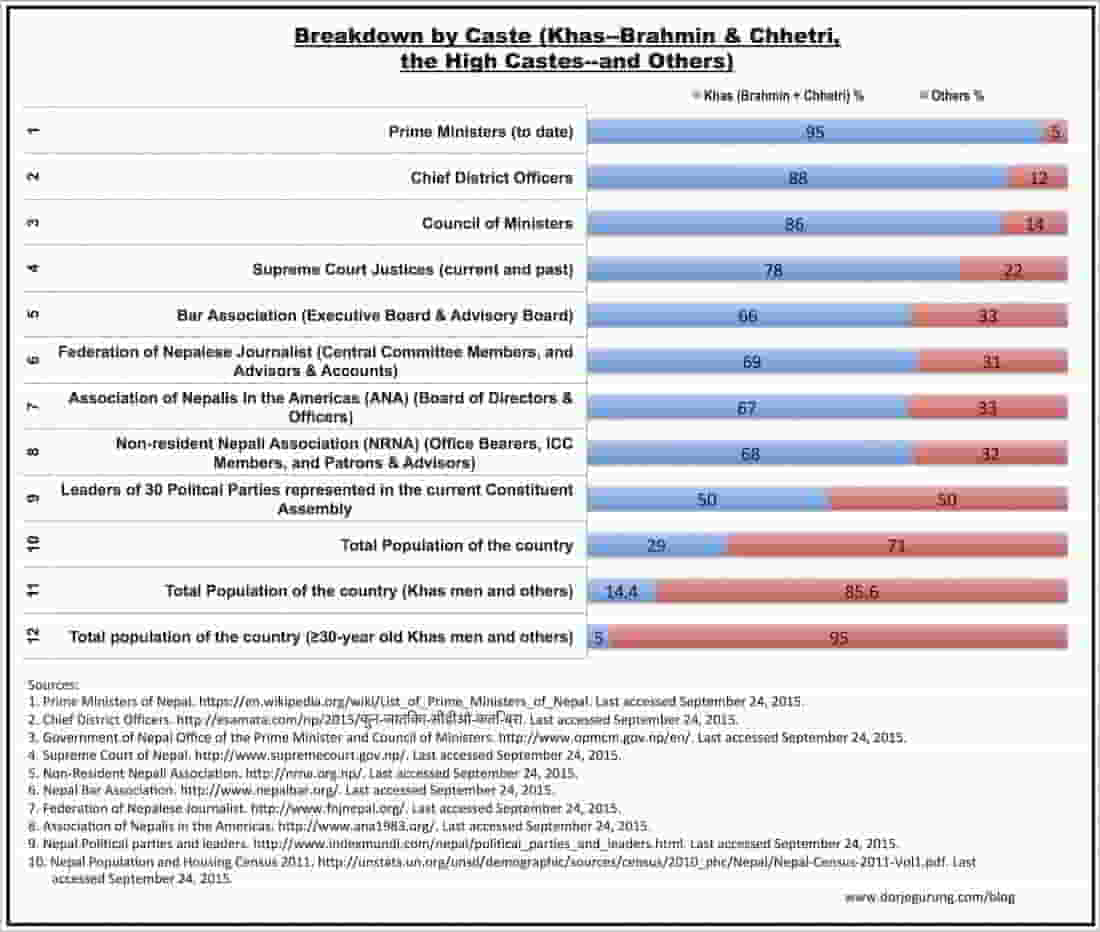
Information educates and empowers people to make informed decisions; there is no doubt about that. With that in mind, I shared one of the early versions of the above chart on my Facebook timeline on September 28 and then on October 23 the version that appears above. And on October 26, yet another version of the chart, breaking down the composition into Bahun, Chhetri and others. I also shared the charts on other pages.
[bctt tweet=”Information educates and empowers people to make informed decisions.” username=”Dorje_sDooing”]
Obviously, it got shared by others and got commented on as well. Some of the responses were surprising, not only for their content but also for who they appeared to come from, and a couple of reactions were interesting!
For those of you not familiar with the Nepalese social system, Nepalese are divided into — depending on the source — four or five castes. The division was carried out by the High Castes. The High Castes — the top two castes — are Brahmin (Bahuns) and Chhetri, respectively, and together they are referred to as the Khas people. The rest of the Nepalese slot into the other lower castes. (I devote a whole series of posts to the caste system.)
It’s Education, Stupid!
Many of the comments attempting to “explain” the disproportionate representation had something to do with (the higher level of?) education of the High Castes compared to the rest. Here’s one.

The following were comments made by two different Nepalese under the chart I shared with the United Nepal Facebook Group.


The irony is that the same people who ascribe ascension of high castes to those positions of power and influence to education (which isn’t entirely true) also argue AGAINST disseminating information such as these (see below)! I guess those people aren’t educated enough to know/understand the educational value of information!
What’s more, those people don’t themselves seem to be “educated” enough to see beyond that. In other words, assuming that the explanation is indeed “education”, they don’t seem to question, or don’t seem to have sufficient insight into, how it is that the high castes are so disproportionately “educated”!
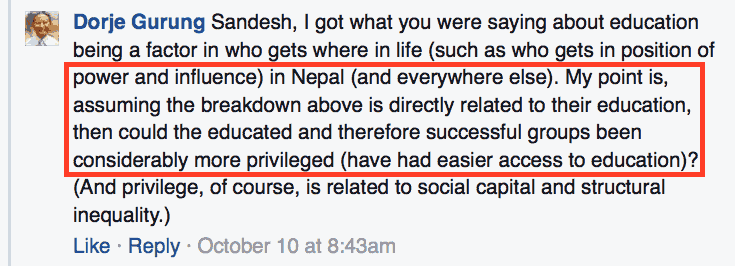
Statistics as a Promoter of all Things Bad
The following were again comments made by a Nepalese also under the post in United Nepal Facebook Group.
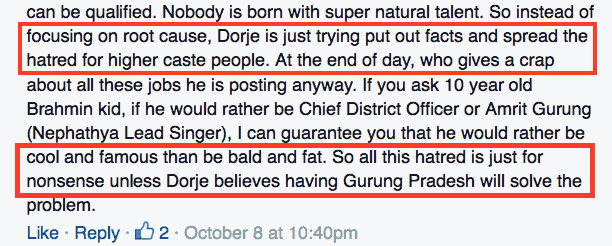


This isn’t the first time that I have had that. In a Facebook post about statistics breaking down Chief District Officers by caste, someone accused me of “inciting inter-caste hatred” and another stated that “taking such stats leads to racism.”
And the Condescension
The guy who posted the comments reproduced above, repeated over and over again how he and his generation didn’t believe in the caste system and how they don’t subscribe to the system etc. What was more telling was his patronizing attitude towards me, as you can see below, which I pointed out kind of sarcastically but he missed it completely.
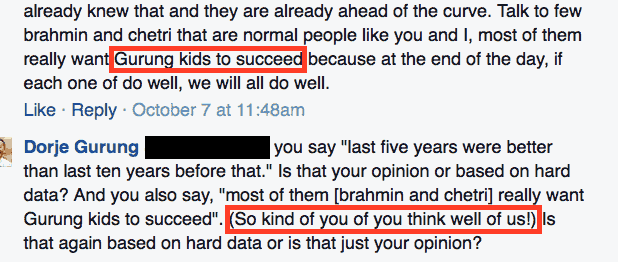 I know he missed it because, not long after that, he came up with this comment:
I know he missed it because, not long after that, he came up with this comment:
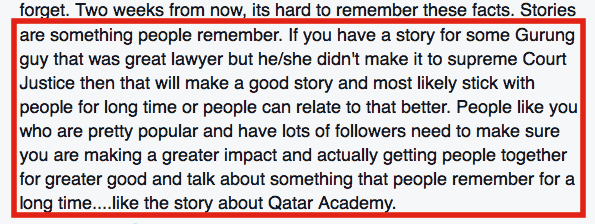 And so I spelled it out for him.
And so I spelled it out for him.
 But I doubt he got the message!
But I doubt he got the message!
Of course, with some high castes, they probably never even become aware that they are being patronizing because that’s the only language they know. Some use language deliberately to belittle, humiliate, intimidate others and thereby, as we say in Nepali, “put them in their [social] place.”
What’s more, structural privilege makes the privileged, according to Pramod Mishra, conceited. Structural privilege also blinds the privileged to their privileges, privileges aptly referred to as the invisible doko in a blog post of the same title. No wonder, one of the commenters had this to say:

(Some are either so cunning, or so clueless, as to also endorse the caste system by appealing to some sad and farcical argument about “unity in diversity.”)
* * * * * * * *
On October 6, I shared the chart with a Nepalese men’s Facebook Group called Men’s Room Reloaded. Within two hours of doing so, I was kicked out of the group.
A couple of weeks later I discovered that I had been banned from the group and the reason was most likely because I had violated one of the terms of group membership.
The description of the group includes the following lines.
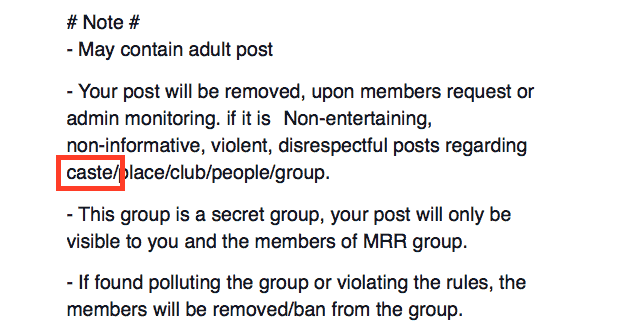
Just like the above commenters, an administrator or administrators most likely perceived this as being disrespectful of some castes or possibly even inciting inter-caste hatred or animosity!
I was able to get a screen shot of the last comment.
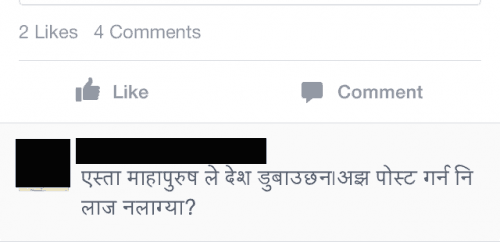
The prize for the best comment, however, goes to the person who, sharing the modified version of the above chart, had the following to say:
More than anything, the charts show who is privileged — structurally privileged — in Nepal and how much Nepalese society suffers from structural inequality. For more on that, you’ll have to wait for the follow-up blog post.
In the mean time, for more on what privilege in Nepal looks like, click here.
* * * * * * *
Click here for the follow-up blog post.
* * * * * * * *
Oct. 26, 2017 Update
Following someone sharing this blog post on Reddit a couple of days ago, a lively debate appears to have ensued on the platform. Most reactions however are standard and pathetic objections, knee-jerk defensive reactions, fallacy-ridden arguments about what’s wrong with the chart and why reservations (affirmative action) should NOT be implemented in Nepal etc. None of them new to me, of course!
I share below just three examples.
In the following the user, no different from some others, displayed their bigotry without even being aware! In it the user psychedlic_breakfast reveals more about the kind of a person s/he is than shedding any light on the people (the non-Khas-aryas) s/he characterizes. (We’ll ignore the fact that the chart does NOT show what s/he says it shows.)
And the same user provides the standard drivel most nationalists do when discussing inclusion and the need to address structural inequalities and inequities in the country (which I have responded to in the satirical blog post All for National Unity… Well Maybe Not… All!).
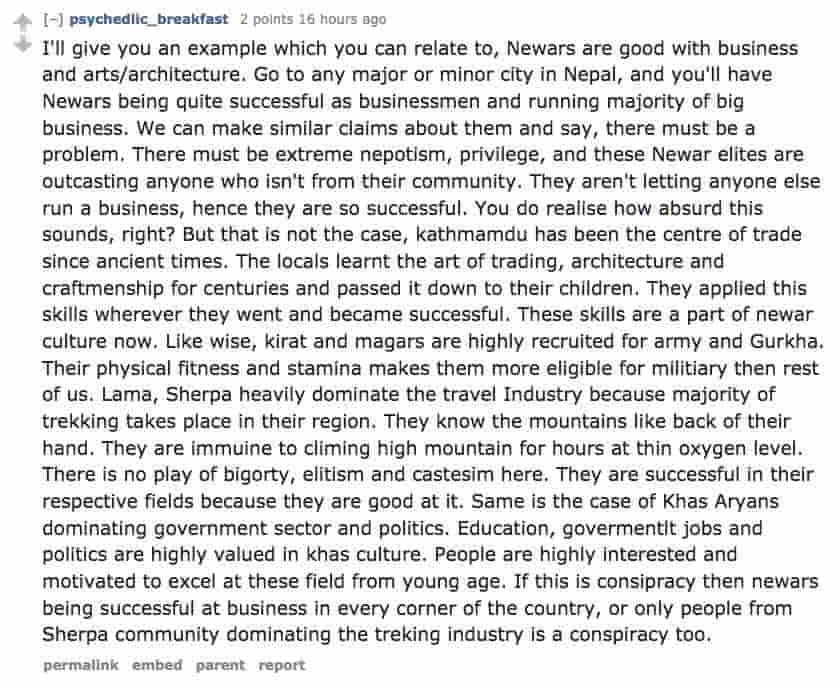
The following one, by the user skynet3000, makes no logical sense in light of what it’s supposed to be (a response to a chart showing the breakdown of different bodies by caste). If s/he actually believes that that’s the kind of “logical” argument people make when debating inclusion and representation then s/he has never been in such a debate or, if s/he has, they must have been debates where fallacy-ridden arguments are made. Plus, the user wants us to believe that, without having personally “verified the accuracy of the figures” they appear “to be cherry picked”! I wish I had such skills! 😀 😀
I saw NO EVIDENCE to suggest that EVEN A SINGLE user objecting to the chart was actually aware of structural issues in the country, such as structural privilege, structural inequity and structural inequality.
* * * * * * * *
References
National Population and Housing Census 2011.
Facebook comment about success in bureaucracy being “directly related to education” and “You may find hundreds of reasons to blame Bahuns for your own failure”.
September 28 Facebook post of the earlier version of the charts.
October 23 Facebook post of chart appearing at the top.
October 26 Facebook post of revised version of the chart, one where composition is broken down into Brahmin, Chhetri and others.
United Nepal Facebook Page post and exchanges.
Facebook Post about CDO breakdown and exchanges.
For the people. Written before the promulgation of the constitution, about the need to invite Madhesi and Janajati leaders to discuss the constitution and how privilege is blinding the high castes, stifling their creativity and making them conceited, among other things.
The Invisible Doko. The blog post identifies the “subtle benefits of khas privilege” in the country. (Khas, again, are the hill so-called high caste Hindus — the Brahmins and the Chhetris.)
The following don’t appear in the blog post but were added later for their relevance.
Reimagining Inclusion. “[Within the elites,] there is a denial of structural power inequalities, either deliberate, cognitive or both, which are underpinned by certain discourses and subjecthood as explored below.”…”The elites and dominant social groups in general tend to defend their social position on the grounds of hard work and education.”…”The other dominant narrative is that deprivation and marginalisation exist within every communities and thus, everyone deserves equal treatment.” [Added on June 1, 2018.]
White Privilege. The link is to a meme which says: “White privilege doesn’t mean your life hasn’t been hard; it means that your skin color isn’t one of the things making it harder.” Similarly, we can say this about Khas privilege.
“Khas privilege doesn’t mean your life hasn’t been hard; it means that your caste isn’t one of the things making it harder.”
[Added Nov. 30, 2018.]
Research Gate (Nov. 2015). The Ain of 1854 and after: Legal pluralism, models of society and ethnicity in Nepal. [Added on Nov. 30, 2018.]
Medium (Nov. 27, 2018). This ‘Equity’ picture is actually White Supremacy at work. “We’ve all seen this picture, right?
“In a picture-is-worth-1,000-words kind of way, this image simplifies the profound difference between equality and equity. From this picture people have actually begun to understand that treating everyone equally doesn’t lead to equity, and in fact, equal treatment often perpetuates and justifies racial hierarchies. Yes, this picture has taught us a lot.” [Added on Nov. 30, 2018.]
The Kathmandu Post (Feb. 5, 2019). Structural blindness. “The foundation of modern Nepal lies in the caste system of governance.” “Lower castes faced greater punishments than higher castes for the same crime. for example, in 1940, for protesting against the Ranas, Tanka Prasad Acharya, a Brahmin, was imprisoned; his four friends, charged with same crime, were hanged and shot to death.” [Added Feb. 5, 2019.]
CultureNep (July 16, 2020). Book Review: Fatalism and Development by Dor Bahadur Bista. Written by a Nepali with the surname Bhattarai (a Brahmin), what caught my eyes: “Brahmins have the highest achievement motivation[.]” I wonder if the author considered what, if anything, achievement motivation is a function of. My guess? Probably a number of variables, one of which is likely social capital! And guess which social group in the Indian Subcontinent likely has the LARGEST social capital? The Brahmains! They are after all the higest caste! [Added on July 20, 2021.]

